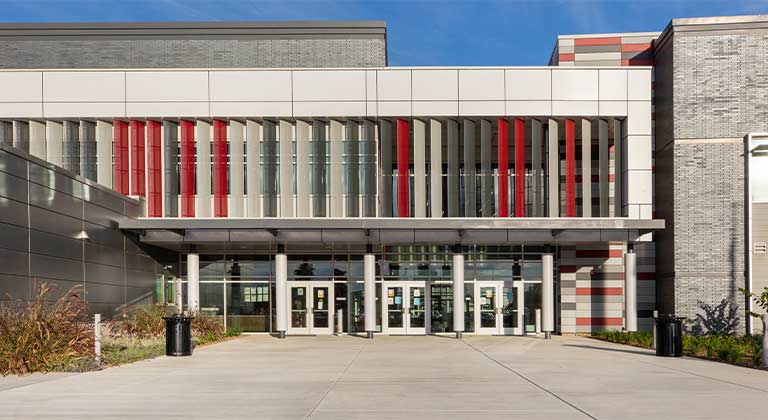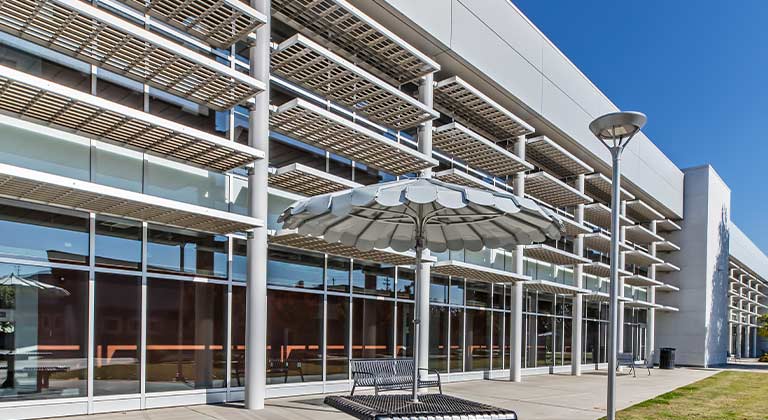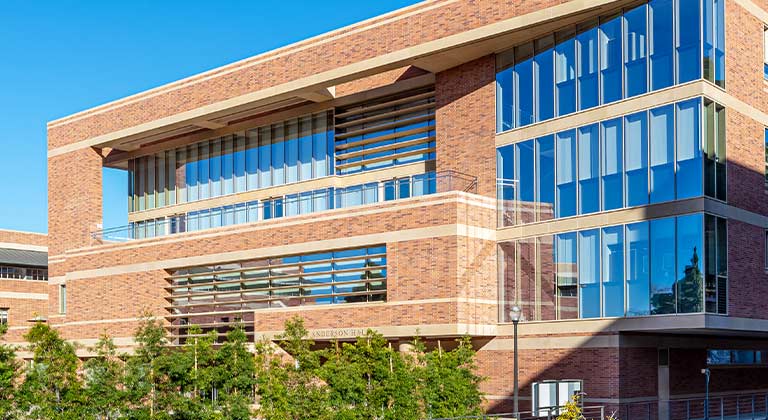
A louver is a series of parallel, usually horizontal slats that regulate airflow or light penetration, while providing protection against vision, water and noise intrusion. They can be either fixed in place, or movable so that the amount of light or moisture allowed in can be adjusted as needed.
Window louvers enable architectural creativity while allowing the functional and practical benefits that windows provide.
Louvers can be installed on the doors and windows of commercial buildings to achieve various goals, including functionality, energy efficiency, and design aesthetics.
The following paragraphs will review window louvers’ creative use and functional benefits as part of commercial building envelopes to improve overall comfort, energy efficiency, and aesthetics.
What are Window Louvers, and What Are They Used For?
A window louver is a type of covering placed over a window containing horizontal slats that can be angled to let in levels of air and light while keeping out rain, unwanted noise and direct sunlight.
Historically, louvers have been commonly used in architecture for the past few hundred years. Since the 18th and 19th centuries, louvers have assisted in cooling buildings in hot climates by blocking direct sunlight. They were used in industrial settings as well, to enable excess heat, chimney smoke and steam escape internal environments. Some modern louver systems also serve to enhance indoor daylighting.
Mirrored louver systems that are fixed can effectively reduce glare and redirect diffuse light. These louvers can be integrated between two double-glazed panes. In industrial settings, such as steel foundries and power plants, louvers are often used for natural ventilation and temperature regulation.
Louvers commonly were installed in bell towers to allow maximum sound output while protecting the bells from the elements.
Currently louvers are installed in buildings serving many diverse purposes. In addition to residential use, they are often installed on the windows of medical facilities, food-related businesses and restaurants, and offices and other commercial buildings.

Common Louver Types
Let’s review some of the most common types of louvers and their uses.
Stationary Louvers
The most common industrial louver is the stationary louver, which may be either fixed in place or mounted on tracks. This type has no moving parts, and is often made of metal or plastic, utilizing a curved design to control airflow.
Stationary louvers are fixed to objects for sun shading on windows and doors.
Adjustable Louvers
Adjustable louvers let you adjust their positioning so you can control the airflow in your space. These louvers use hinges that allow you to open and close them manually.
Combination Louvers
As the name suggests, combination louvers have features that allow some sections to be adjusted and some, stationary. They have slats that are both stationary and adjustable combined into one component and help to control airflow and retain heat inside a building.
Air Measuring Louvers
These louvers have narrow vertical blades and are primarily used in industrial buildings. They protect against snow or rain while allowing the building to ventilate.
Other Ways to Use Louvers
The flexibility of louver shapes, sizes, and colors allows designers to choose among them, based on the specific requirements and location of a building.
- Industrial Louvers: Industrial louvers are weather-resistant structures installed on top of a building’s exterior walls, are made of metal or wood, and are primarily used in warehouses or factories that generate heat.
- Commercial Louvers: Commercial louvers provide ventilation without obstruction. Best used in commercial buildings such as airports and grocery stores, these are often manufactured from metal or plastic for durability and easier cleaning.
- Architectural Louvers: These louvers provide shade, privacy, natural light, and aesthetic appeal to buildings. They are mostly installed over doors, windows, and other openings on the building façade.

Benefits of Using Window Louvers in Commercial Buildings
There are many benefits to using louvers in commercial buildings. However, there are a couple that stand out more than the rest. These benefits include:
- Enhanced energy efficiency
- Improved comfort and air quality
- Increased design flexibility and aesthetics
Louvers enable the flow of air while simultaneously preventing rain and debris from entering the building. They serve as a practical and efficient way to conceal unattractive equipment on buildings or as a cost-effective aesthetic element for the façade.
Their flexibility allows designers to choose louvers to meet a wide range of performance goals that include:
- non-drainable
- drainable
- wind-driven rain resistant
- thin-lined
- combination
- acoustically rated and adjustable
- extreme-weather resistant.
Louvers can be customized in a material that complements your building design, such as aluminum, timber, or glass, and also powder coated to match the joinery.
Before purchasing a louver system, it’s important to understand their purpose and how they work clearly. This will ensure you select the right louver design to meet your needs.

Challenges in Commercial Glass Installations and How Window Louvers Address These Issues
While windows serve several common functions in buildings, installing window louvers on some areas of your building can address the same issues more effectively. Some of the challenges louvers address include:
- Airflow
- Prevention of pests, rodents or dirt from entering
- Privacy
- Aesthetics
- Prevention of rain from entering
- Noise reduction
Airflow
When fully open, louver blades are close to horizontal. This means they provide little resistance to the air entering through the window opening. In effect, this allows for twice as much ventilation as would be possible through a same-sized sliding window or a double-hung window. Additionally, they’re ideal for internal windows to continue cooling and refreshing the building.
Keep Vermin and Rain Out ButLet Sunlight In
The blades on louvers can be angled differently depending on need and the environmental situation. If allowing in light is a priority, the blade angles can be widened. If you need protection from insects, rain, dirt, or debris from the outside, by changing the angles and spacing of the louver blades, you can prevent any such access to your building interior.
Privacy and Aesthetics
Windows are not always an appropriate or the right solution for a given space. When this is the case, louvers can be a great alternative.
Angling your louvers provides privacy when needed. Whether it’s at night when interior lights are turned on, at street level and visible to passersby, or when windows are in unobstructed view of other buildings, louvers can be adjusted to meet the privacy needs of the tenant or the moment, while still enabling airflow.
Louvers are available in various shapes and sizes. They can be manufactured in multiple colors and styles of finishes, so that designers can easily source louvers to complement a building’s design.
Best Practices for Installing Window Louvers in Commercial Buildings
Shop-assembled louvers typically arrive on-site fully assembled and ready to install. Prior to their installation, however, an experienced glazing crew will conduct several necessary checks.
Before installation, it is essential to confirm that the size of the louver and the surrounding conditions are accurate. Additionally, the louver opening should be appropriately waterproofed or flashed. It is also necessary to have all the required steel or studs in place for attachment.
During the installation of louvers, a common challenge is that on-site conditions may differ from the original architectural or submitted plans. It is crucial for the glazing contractor to thoroughly inspect all aspects of the louver submittals to confirm that the product was manufactured correctly and can be immediately installed.
To ensure success, it is crucial to plan and guarantee dimensions during the initial phases of a project, and to verify during construction of those areas that openings have not deviated from the original measurements. Additionally, it is essential to consider the environment in which the louver will be installed.
Before installing the attachment hardware, it’s critical to confirm that there’s enough space behind the louver. The wall must be deep enough to accommodate the installation hardware. It’s also crucial to ensure that the surrounding conditions can support all the loads associated with the louver, such as dead and wind loads.
As a side note, the louver system should possess a rating from the Air Movement and Control Association (AMCA). This will confirm that the system has undergone AMCA testing and certification. This information is typically included in the manufacturer’s technical data sheet.
In certain situations, frames may need to be adjusted to fit different types of buildings. This often happens when louvers are installed in a curtain wall. In these cases, louvers can be glazed in, similar to how glass is installed.
Giroux Glass Knows Commercial Glass and Window Louvers
Window louvers are versatile features that provide commercial buildings with substantial visual appeal and practical advantages. They provide control of light, glare, noise, privacy and moisture while allowing air to flow in and out of buildings. They can be manufactured in a wide array of colors and finishes that will complement any building’s design.
For them to perform at peak efficiency, louvers should be installed by experienced glazing professionals such as our team at Giroux Glass. For over seven decades and in many diverse types of buildings, we have successfully installed louvers — as well as every other element of a building’s façade.
For more information on incorporating window louvers in your commercial glass project, contact Giroux Glass today to discuss your options.